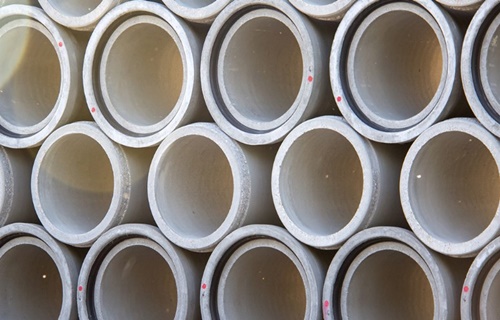Are Transite Water Pipes a Health Hazard?

Products made of asbestos cement lend themselves to rapid construction, and as a consequence, they have been extensively used for housing and industrial buildings. Approximately half of the asbestos mined in the U.S. in the last century was utilized for asbestos-cement sheets, pipes, and floor tiles. Reports show that in the 1950s, manufacturers produced an estimated one billion square feet of asbestos-cement products for the construction industry.
Asbestos has been utilized for pipe manufacturing since the late 1800s; its tiny fibers mixed well in cementitious products and were an ideal strengthening material. Asbestos cement was usually made with white chrysotile asbestos and sometimes silica flour as additional reinforcement - a hazardous combination of toxic components that endanger human health. The relative proportions of asbestos fibers in cement may vary with the product's particularities - generally, 10% to 75% of chrysotile asbestos was mixed in building products like:
- pipes
- flat or corrugated sheets
- roofing or siding shingles
- clapboard
- hand molded products
- wall boards
Asbestos or transite pipes were first used for potable water distribution systems in the mid-1940s. They were also utilized nationwide to transport gases, exhaust fumes, and drain wastewater. Moreover, transite pipes were laid down for water supply systems in some U.S. municipalities up into the 1970s. Still, the pipes were easily broken because they could not reliably withstand high water pressures. Given that asbestos cement loses its impact strength over time, pipes laid down in the heyday of asbestos-containing construction materials represent a significant risk of asbestos exposure.
As asbestos-cement pipes corrode, they lose mechanical strength and soften, becoming brittle and more vulnerable to damage. They may release asbestos particles in water and represent a potential risk of asbestos exposure by ingestion. However, it is essential to note that the hazardous asbestos fibers released from the pipe's interior into the drinking water flowing through that conduit represent an uncertain level of health risk, as measurements made to estimate their quantity resulted in conflicting numbers. Asbestos exposure from contaminated drinking water is probably low. Still, because no amount of exposure is safe, it is better to assess the state of transite pipes in your home and keep an eye on them for the long haul.
The Hazard of Vinyl-Lined Asbestos Pipes
A more immediate water contamination risk comes from vinyl-lined transite water pipes, which release tetrachloroethylene into the water running through them. Asbestos cement pipes were discovered to cause high alkalinity and poor-tasting water in the late 1960s, and to address the taste problem, transite pipes were lined with vinyl.
VLAC pipes were produced by diluting resin with PCE, a solvent, and then spraying the mixture onto the inside of the transite pipe. Only in the late 1970s did the discovery of VLAC pipes leaching PCE into the water become public, and another health concern rose. Although the manufacturing of VLAC pipes ceased in 1980, manufacturers sold thousands of miles of line by then.
Both asbestos and tetrachloroethylene are carcinogens, and drinking water contaminated with these toxic substances over an extended period considerably increases the risk of developing a malignant disease.
Identifying Asbestos Pipes Is Essential
As transite piping deteriorates over time, the risk of exposure to asbestos increases exponentially. Many asbestos-containing products in buildings are often evident and easy to recognize, but since visual identification can be faulty, contacting a certified professional is advisable.
A transite pipe may be smooth, but often it has a screen-like mesh pattern on the exterior and may be mistaken for plastic. Still, it'd be reasonable to suspect asbestos cement if it's not PVC and the pipe's surface is brittle and cementitious.
Asbestos-containing products are safe to remain in homes as long as they are in good condition. If the pipes present deterioration signs or leaks, they'll need repair, rehabilitation, or replacement. Any work should be done without damaging them, as they can shed tiny asbestos fibers and contaminate the surrounding environment. Homeowners should consider hiring professionals, as they have the necessary tools and equipment for handling asbestos.
